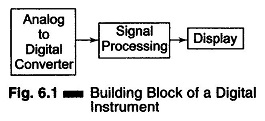What is a Digital Instrument?:
Digital instrument are rapidly replacing their analog counterparts. The parameters of interest in a laboratory environment are (i) voltage (ii) current (iii) power (iv) frequency, and (v) logic.
We shall consider digital systems which measure the above parameters. To enable digital systems to recognize information, inputs which are analog in nature must be converted to digital form. Hence any digital instruments would invariably consist of an analog to digital converter in its input stage. The basic building block of a digital instrument is shown in Fig. 6.1.
The display block may be analog or Digital Instruments in nature. If an analog readout is desired, it becomes necessary to include a stage involving digital to analog conversion.
Digital systems may consist of the following components.
- Resistors
- Capacitors
- Transistors
- Linear ICs
- Digital ICs
- Display devices
- Analog to digital converters
- Digital to analog converters
The digital form of measurement can be used to display the measured quantity numerically instead of a deflection, as in conventional analog meters. Data in digital form facilitates various operations that are normally required in signal processing. An increase in the availability and type of computer facilities and a decrease in the cost of various modules required for digital systems is accelerating the development of digital instrumentation for measurement and signal processing.
